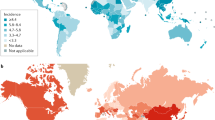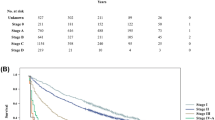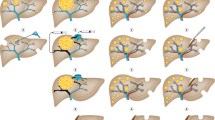Abstract
Hepatocellular carcinoma (HCC) generally develops as a consequence of underlying liver disease, most commonly viral hepatitis. The development of HCC follows an orderly progression from cirrhosis to dysplastic nodules to early cancer development, which can be reliably cured if discovered before the development of vascular invasion (typically occurring at a tumor diameter of approximately 2 cm). The identifiable population at risk makes screening a realistic possibility, and liver imaging is recommended every 6 months for patients with cirrhosis. For patients with preserved liver function and no portal hypertension who develop HCC that is confined to one region of the liver, resection is the preferred treatment. If resection is not possible because of poor liver function, and the HCC is within the Milan criteria (1 nodule ≥5 cm, 2–3 nodules ≥3 cm), liver transplantation is the treatment of choice. To prevent tumor progression while waiting, nonsurgical treatments including percutaneous ethanol injection, radiofrequency ablation, and transarterial chemoembolization are employed, but drop-out from the waiting list remains a problem. Living donor transplantation is an alternative that can eliminate drop-out and enable liver transplantation for patients with HCC whose disease does not fall within the Milan criteria. There is a need for more effective adjuvant therapies after resection and liver transplantation; newer antiangiogenic agents offer hope for improved outcomes in the future.
Key Points
-
If discovered at an early stage, HCC is potentially curable by surgery
-
When localized HCC is discovered in patients with preserved liver function and no portal hypertension, resection is the preferred treatment
-
If resection is not possible (e.g. because of poor liver function) and the HCC is within the Milan criteria, liver transplant is the treatment of choice
-
Nonsurgical treatments (PEI, RFA, and TACE) are employed to minimize drop-out from the transplant waiting list, which nevertheless occurs in 20% of patients
-
Living donor liver transplantation is an alternative treatment that can eliminate drop-out and enable liver transplant in patients with HCC beyond the Milan criteria
-
There is a need for more-effective medical therapies; newer agents targeting angiogenesis are promising in this regard
This is a preview of subscription content, access via your institution
Access options
Subscribe to this journal
Receive 12 print issues and online access
$209.00 per year
only $17.42 per issue
Buy this article
- Purchase on Springer Link
- Instant access to full article PDF
Prices may be subject to local taxes which are calculated during checkout
Similar content being viewed by others
References
El Serag HB and Mason AC (1999) Rising incidence of hepatocellular carcinoma in the United States. N Engl J Med 340: 745–750
Kew MC and Popper H (1984) Relationship between hepatocellular carcinoma and cirrhosis. Semin Liver Dis 4: 136–146
Department of Health and Human Services Centers for Disease Control and Prevention National Health and Nutrition Examination Survey [http://www.cdc.gov/nchs/data/nhanes/databriefs/viralhep.pdf] (accessed 14 April 2007)
Kramer JR et al. (2005) The effect of HIV coinfection on the risk of cirrhosis and hepatocellular carcinoma in US veterans with hepatitis C. Am J Gastroenterol 100: 56–63
van Spronsen FJ et al. (2005) Hepatocellular carcinoma in hereditary tyrosinemia type I despite 2-(2 nitro-4-3 trifluoro-methylbenzoyl)-1, 3-cyclohexanedione treatment. J Pediatr Gastroenterol Nutr 40: 90–93
Nagasue N and Kohno H (1992) Hepatocellular carcinoma and sex hormones. HPB Surg 6: 1–6
Tong MJ et al. (1995) Clinical outcomes after transfusion-associated hepatitis C. N Engl J Med 332: 1463–1466
International Working Party (1995) Terminology of nodular hepatocellular lesions. Hepatology 22: 983–993
Borzio M et al. (1995) Liver cell dysplasia is a major risk factor for hepatocellular carcinoma in cirrhosis: a prospective study. Gastroenterology 108: 812–817
Grisham JW (2001) Molecular genetic alterations in primary hepatocellular neoplasms: hepatocellular adenoma, hepatocellular carcinoma, and hepatoblastoma. In The Molecular Basis of Human Cancer, 269–346 (Eds Coleman WB and Tsongalis GJ) Totowa: Humana Press
Kobayashi M et al. (2006) Dysplastic nodules frequently develop into hepatocellular carcinoma in patients with chronic viral hepatitis and cirrhosis. Cancer 106: 636–647
Sugihara S et al. (1992) The morphologic transition in hepatocellular carcinoma: a comparison of the individual histologic features disclosed by ultrasound-guided fine-needle biopsy with those of autopsy. Cancer 70: 1488–1492
Kenmochi K et al. (1987) Relationship of histologic grade of hepatocellular carcinoma (HCC) to tumor size, and demonstration of tumor cells of multiple different grades in single small HCC. Liver 7: 18–26
Fattovich G et al. (1997) Morbidity and mortality in compensated cirrhosis type C: a retrospective follow-up study of 384 patients. Gastroenterology 112: 463–472
Sakuma K et al. (1982) Prognosis of hepatitis B virus surface antigen carriers in relation to routine liver function tests: a prospective study. Gastroenterology 83: 114–117
Bruix J and Sherman M ; Practice Guidelines Committee, American Association for the Study of Liver Diseases (2005) Management of hepatocellular carcinoma. Hepatology 42: 1208–1236
Colli A et al. (2006) Accuracy of ultrasonography, spiral CT, magnetic resonance, and alpha-fetoprotein in diagnosing hepatocellular carcinoma: a systematic review. Am J Gastroenterol 101: 513–523
Tsai TJ et al. (2000) Clinical significance of microscopic tumor venous invasion in patients with resectable hepatocellular carcinoma. Surgery 127: 603–608
Peng SY et al. (2004) High alpha-fetoprotein level correlates with high stage, early recurrence and poor prognosis of hepatocellular carcinoma: significance of hepatitis virus infection, age, p53 and beta-catenin mutations. Int J Cancer 112: 44–50
Llovet JM et al. (1999) Intention-to-treat analysis of surgical treatment for early hepatocellular carcinoma: resection versus transplantation. Hepatology 30: 1434–1440
Livraghi T et al. (2004) Multimodal image-guided tailored therapy of early and intermediate hepatocellular carcinoma: long-term survival in the experience of a single radiologic referral center. Liver Transpl 10: S98–S106
Okamoto E et al. (1984) Prediction of the safe limits of hepatectomy by combined volumetric and functional measurements in patients with impaired hepatic function. Surgery 95: 586–592
Turcotte JG and Lambert MJ III (1973) Variceal hemorrhage, hepatic cirrhosis, and portacaval shunts. Surgery 73: 810–817
Thalheimer U et al. (2004) Targeting portal pressure measurements: a critical reappraisal. Hepatology 39: 286–290
Bruix J et al. (1996) Surgical resection of hepatocellular carcinoma in cirrhotic patients: prognostic value of preoperative portal pressure. Gastroenterology 111: 1018–1022
Roayaie S et al. (2000) Comparison of surgical outcomes for hepatocellular carcinoma in patients with hepatitis B versus hepatitis C: a western experience. Ann Surg Oncol 7: 764–770
Ng IO et al. (2003) Determination of the molecular relationship between multiple tumour nodules in hepatocellular carcinoma differentiates multicentric origin from intrahepatic metastasis. J Pathol 199: 345–353
Ohkubo T et al. (2000) Surgical results for hepatocellular carcinoma with macroscopic portal vein tumor thrombosis. J Am Coll Surg 191: 657–660
Koike Y et al. (2003) Factors affecting the prognosis of patients with hepatocellular carcinoma invading the portal vein—a retrospective analysis using 952 consecutive HCC patients. Hepatogastroenterology 50: 2035–2039
Fong Y et al. (1999) An analysis of 412 cases of hepatocellular carcinoma at a Western center. Ann Surg 229: 790–799
Chen WT et al. (2004) Recurrent hepatocellular carcinoma after hepatic resection: prognostic factors and long-term outcome. Eur J Surg Oncol 30: 414–420
Chen YJ et al. (2000) Chromosomal changes and clonality relationship between primary and recurrent hepatocellular carcinoma. Gastroenterology 119: 431–440
Finkelstein SD et al. (2003) Microdissection-based allelotyping discriminates de novo tumor from intrahepatic spread in hepatocellular carcinoma. Hepatology 37: 871–879
Lau WY et al. (1999) Adjuvant intra-arterial iodine-131-labelled lipiodol for resectable hepatocellular carcinoma: a prospective randomised trial. Lancet 353: 797–801
Boucher E et al. (2003) Adjuvant intra-arterial injection of iodine-131-labeled lipiodol after resection of hepatocellular carcinoma. Hepatology 38: 1237–1241
Yoshida H et al. (2004) Benefit of interferon therapy in hepatocellular carcinoma prevention for individual patients with chronic hepatitis C. Gut 53: 425–430
Chen CJ et al. (2006) Risk of hepatocellular carcinoma across a biological gradient of serum hepatitis B virus DNA level. JAMA 295: 65–73
Muto Y et al. (1996) Prevention of second primary tumors by an acyclic retinoid, polyprenoic acid, in patients with hepatocellular carcinoma. Hepatoma Prevention Study Group. N Engl J Med 334: 1561–1567
Lin SM et al. (2004) Radiofrequency ablation improves prognosis compared with ethanol injection for hepatocellular carcinoma < or = 4 cm. Gastroenterology 127: 1714–1723
Shiina S et al. (2005) A randomized controlled trial of radiofrequency ablation with ethanol injection for small hepatocellular carcinoma. Gastroenterology 129: 122–130
Llovet JM et al. (2002) Arterial embolisation or chemoembolisation versus symptomatic treatment in patients with unresectable hepatocellular carcinoma: a randomised controlled trial. Lancet 359: 1734–1739
Llovet JM and Bruix J (2003) Systematic review of randomized trials for unresectable hepatocellular carcinoma: chemoembolization improves survival. Hepatology 37: 429–442
Mazzaferro V et al. (1996) Liver transplantation for the treatment of small hepatocellular carcinomas in patients with cirrhosis. N Engl J Med 334: 693–699
Mutimer DJ et al. (2006) Impact of donor age and year of transplantation on graft and patient survival following liver transplantation for hepatitis C virus. Transplantation 81: 7–14
Bismuth H et al. (1999) Liver transplantation for hepatocellular carcinoma. Semin Liver Dis 19: 311–322
Yao FY et al. (2001) Liver transplantation for hepatocellular carcinoma: expansion of the tumor size limits does not adversely impact survival. Hepatology 33: 1394–1403
Roayaie S et al. (2002) Long-term results with multimodal adjuvant therapy and liver transplantation for the treatment of hepatocellular carcinomas larger than 5 centimeters. Ann Surg 235: 533–539
Schwartz ME et al. (1995) Multifocality of hepatocellular carcinoma in cirrhosis: a clinico–pathologic study [abstract]. In Proceedings of the European IHPBA Congress: 1995 May 25–28; Athens, 699. Bologna: Monduzzi Editore SpA
Marsh JW et al. (1997) The prediction of risk of recurrence and time to recurrence of hepatocellular carcinoma after orthotopic liver transplantation: a pilot study. Hepatology 26: 444–450
Cillo U et al. (2004) Liver transplantation for the treatment of moderately or well-differentiated hepatocellular carcinoma. Ann Surg 239: 150–159
Marsh JW et al. (2003) Genotyping of hepatocellular carcinoma in liver transplant recipients adds predictive power for determining recurrence-free survival. Liver Transpl 9: 664–671
Yao FY et al. (2002) Liver transplantation for hepatocellular carcinoma: analysis of survival according to the intention-to-treat principle and dropout from the waiting list. Liver Transpl 8: 873–883
Decaens T et al. (2005) Impact of pretransplantation transarterial chemoembolization on survival and recurrence after liver transplantation for hepatocellular carcinoma. Liver Transpl 11: 767–775
Gondolesi GE et al. (2002) Venous hemodynamics in living donor right lobe liver transplantation. Liver Transpl 8: 809–813
Sarasin FP et al. (2001) Living donor liver transplantation for early hepatocellular carcinoma: a life-expectancy and cost-effectiveness perspective. Hepatology 33: 1073–1079
Gondolesi GE et al. (2004) Adult living donor liver transplantation for patients with hepatocellular carcinoma: extending UNOS priority criteria. Ann Surg 239: 142–149
Todo S, Furukawa H ; Japanese Study Group on Organ Transplantation (2004) Living donor liver transplantation for adult patients with hepatocellular carcinoma: experience in Japan. Ann Surg 240: 451–459
Casadio F et al. (2005) Toward the definition of immunosuppressive regimens with antitumor activity. Transplant Proc 37: 2144–2147
Guba M et al. (2004) Pro- and anti-cancer effects of immunosuppressive agents used in organ transplantation. Transplantation 77: 1777–1782
Luan FL et al. (2002) Rapamycin blocks tumor progression: unlinking immunosuppression from antitumor efficacy. Transplantation 73: 1565–1572
Kneteman NM et al. (2004) Sirolimus-based immunosuppression for liver transplantation in the presence of extended criteria for hepatocellular carcinoma. Liver Transpl 10: 1301–1311
Zhou J et al. (2006) Conversion to sirolimus immunosuppression in liver transplantation recipients with hepatocellular carcinoma: report of an initial experience. World J Gastroenterol 12: 3114–3118
Rizell M et al. (2005) Impressive regression of primary liver cancer after treatment with sirolimus. Acta Oncol 44: 496
Elsharkawi M et al. (2005) Complete remission of postransplant lung metastases from hepatocellular carcinoma under therapy with sirolimus and mycophenolate mofetil. Transplantation 79: 855–857
Yeo W et al. (2005) A randomized phase III study of doxorubicin versus cisplatin/interferon alpha-2b/doxorubicin/fluorouracil (PIAF) combination chemotherapy for unresectable hepatocellular carcinoma. J Natl Cancer Inst 97: 1532–1538
Johnson PJ (2002) Hepatocellular carcinoma: is current therapy really altering outcome? Gut 51: 459–462
Schwartz JD et al. (2005) Thalidomide in advanced hepatocellular carcinoma with optional low-dose interferon-α2a upon progression. Oncologist 10: 718–727
Schwartz JD et al. (2005) Bevacizumab in hepatocellular carcinoma (HCC) in patients without metastasis and without invasion of the portal vein [abstract #4122]. J Clin Oncol 23 (Suppl 16S)
Wilhelm SM et al. (2004) BAY 43-9006 exhibits broad spectrum oral antitumor activity and targets the RAF/MEK/ERK pathway and receptor tyrosine kinases involved in tumor progression and angiogenesis. Cancer Res 64: 7099–7109
Ahmad T and Eisen T (2004) Kinase inhibition with BAY 43-9006 in renal cell carcinoma. Clin Cancer Res 10 (Suppl): 6388S–6389S
Strumberg D et al. (2005) Phase I clinical and pharmacokinetic study of the novel raf kinase and vascular endothelial growth factor receptor inhibitor BAY 43-9006 in patients with advanced refractory solid tumors. J Clin Oncol 23: 965–972
Philip PA et al. (2005) Phase II study of Erlotinib (OSI-774) in patients with advanced hepatocellular cancer. J Clin Oncol 23: 6657–6663
Pore N et al. (2006) EGFR tyrosine kinase inhibitors decrease VEGF expression by both hypoxia-inducible factor (HIF)-1-independent and HIF-1-dependent mechanisms. Cancer Res 66: 3197–3204
Maataoui A et al. (2005) Transarterial chemoembolization alone and in combination with other therapies: a comparative study in an animal HCC model. Eur Radiol 15: 127–133
Acknowledgements
This work was supported by NIH K24 award # DK 60498-01 entitled, “Systematic integration of patient-oriented research into the clinical pathway for hepatocellular carcinoma”, Myron Schwartz, MD Principal Investigator.
Author information
Authors and Affiliations
Corresponding author
Ethics declarations
Competing interests
The authors declare no competing financial interests.
Rights and permissions
About this article
Cite this article
Schwartz, M., Roayaie, S. & Konstadoulakis, M. Strategies for the management of hepatocellular carcinoma. Nat Rev Clin Oncol 4, 424–432 (2007). https://doi.org/10.1038/ncponc0844
Received:
Accepted:
Issue Date:
DOI: https://doi.org/10.1038/ncponc0844
This article is cited by
-
System analysis based on the cuproptosis-related genes identifies LIPT1 as a novel therapy target for liver hepatocellular carcinoma
Journal of Translational Medicine (2022)
-
Meta-analysis and systematic review of prognostic significance of Glypican-3 in patients with hepatitis B-related hepatocellular carcinoma
VirusDisease (2019)
-
Transarterial radioembolization in patients with hepatocellular carcinoma of intermediate B2 substage
European Journal of Nuclear Medicine and Molecular Imaging (2019)
-
Regulation of transforming growth factor is involved in the efficacy of combined 5-fluorouracil and interferon alpha-2b therapy of advanced hepatocellular carcinoma
Cell Death Discovery (2018)
-
Management of everolimus-associated adverse events in patients with tuberous sclerosis complex: a practical guide
Orphanet Journal of Rare Diseases (2017)



